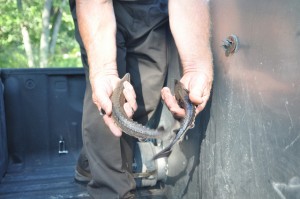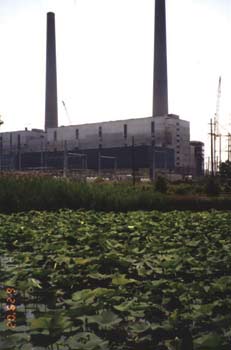
Small sturgeon were raised and released into the Kalamazoo River in 2011. Photo: U.S. Fish and Wildlife Service.
An interactive map showcases successful federal restoration projects in the Great Lakes states, including projects from the $475 million Great Lakes Restoration Initiative.
The map is produced by the Healing Our Waters-Great Lakes Coalition, an association of more than 120 environmental and conservation groups.
Here’s a quick look at what the coalition views as success stories in Michigan:
The Ford Motor Co.’s living roof in Dearborn keeps a factory cool in the summer, warm in the winter, and has decreased the building’s energy use by 7 percent.
The roof, which cost $18 million, reduced polluted runoff by filtering up to 20 billion gallons of stormwater annually, according to the coalition. Oil, grease and chemicals transported by stormwater runoff from manufacturing facilities have polluted the Rouge and Detroit Rivers before. The 10.4-acre roof was part of a $2 billion effort to make Ford’s Rouge truck manufacturing plant more environmentally sustainable.
Other successes include the restoration of lake sturgeon to the Kalamazoo River. This $220,000 project in Fennville has brought back sturgeon after decades of decline.
The U.S. Fish and Wildlife Service released 100 small sturgeon in 2011 and more will be released from a streamside hatchery every year, according to the coalition. Raising the prehistoric fish in water taken from the river allows them to imprint on that particular river, where they will eventually return to spawn, according to the coalition.
Female sturgeon don’t reproduce until they’re 18-20 years old, which can make it hard for them to reproduce in the wild with today’s modern threats. But human assistance has proved successful in other areas of Michigan.
Although there are successes in Michigan, there is also plenty of work in progress, including the restoration of the River Raisin Area of Concern.

The DTE Energy Monroe Power Plant alongside the River Raisin Area of Concern. Photo: Environmental Protection Agency.
The lower portion of the River Raisin was designated an “Area of Concern” because of the toxic chemicals deposited by the city’s industrial boom. After Monroe’s paper mills gave way to auto manufacturing and power plants, polychlorinated biphenyls (PCBs) were found contaminating the area’s sediments.
The EPA and the state of Michigan, authorized through the federal Great Lakes Legacy Act, will dredge the toxic material to repair the damage to fish and wildlife habitat as well as to create room for ship traffic.
Included in the efforts to restore the area are smaller efforts, like Monroe’s $3 million project to install fish passage structures at four dams along the river.
The goal is to create nearly 23 miles of fish and small boat passage from the lower River Raisin to Lake Erie.
Other work in progress includes the U.S. Fish and Wildlife Service’s analysis of Great Lakes emerging concerns by studying herring gull eggs.
This $80,000 project augments a long-existing program that used gull eggs to monitor threats to the lakes’ health. Scientists can see which toxic compounds are present in the eggs and use them to assess the health of surrounding environments.
But this project goes beyond the old program in that scientists can use the data they’ve collected on old and new compounds to see where and when they show up, said Lisa Williams, a biologist at the U.S. Fish and Wildlife Service’s East Lansing field office. And if they see a particular chemical increase over time at a certain location, they may be able to link that with something nearby.

Some environmental contaminants like PCBs are known to cause bill deformities in fish-eating birds, according to the U.S. Fish and Wildlife Service. Photo: U.S. Fish and Wildlife Service.
“One of the things we’ve been really happy to see is that some of the old legacy contaminants PCBs, and DDT-type pesticides, those have been decreasing,” she said.
“But we’ve seen increases in the Great Lakes in some newer chemicals, things like flame retardants.”
These and other restoration projects help Michigan’s economy, according to a report by the Great Lakes Commission, an interstate public conservation agency.
The Great Lakes provide Michigan residents with 800,000 jobs and a commercial fishing industry worth $4 billion, according to the commission. Protection and restoration of the lakes preserves such assets and a $12 billion tourism base. Michigan had a 33 percent increase in tourism-based employment over the past decade, generating 20,000 jobs, the commission reported.